Toronto, a city rich with cultural tapestry and architectural grandeur, offers a journey through time with its historic buildings. Each structure tells a unique story, echoing the city’s vibrant past and continuous evolution. From the majestic Casa Loma, reminiscent of a European castle, to the stately Old City Hall, these historic buildings in Toronto are not just relics of the past but are living monuments of the city’s heritage. After exploring Toronto’s historic buildings, uncover even more of the city’s charm by diving into the top activities and hidden gems that make Toronto truly unique. As we explore Toronto’s best historic buildings, we uncover tales of yesteryear, architectural marvels, and the indelible marks they leave on the city’s skyline. This article invites history enthusiasts and curious travelers alike to delve into the heart of Toronto’s history, revealing why these sites are more than mere attractions; they are the soul of the city itself.
Top 30 Historic Buildings in Toronto
- Casa Loma
- Old City Hall
- St. Lawrence Hall
- Fort York
- Osgoode Hall
- Spadina House
- Elgin and Winter Garden Theatre
- Massey Hall
- Gooderham Building
- Campbell House
- Gibson House
- Colborne Lodge
- Mackenzie House
- Union Station
- Royal Ontario Museum
- Art Gallery of Ontario
- Toronto Dominion Centre
- Commerce Court North
- Hart House
- E.J. Lennox House
- Distillery Historic District
- Black Creek Pioneer Village
- High Park’s Jamie Bell Adventure Playground (historic design elements)
- The Grange
- Queen’s Park Legislative Building
- First Post Office
- John Cox Cottage
- Montgomery’s Inn
- Scarborough Historical Museum
- Todmorden Mills Heritage Site
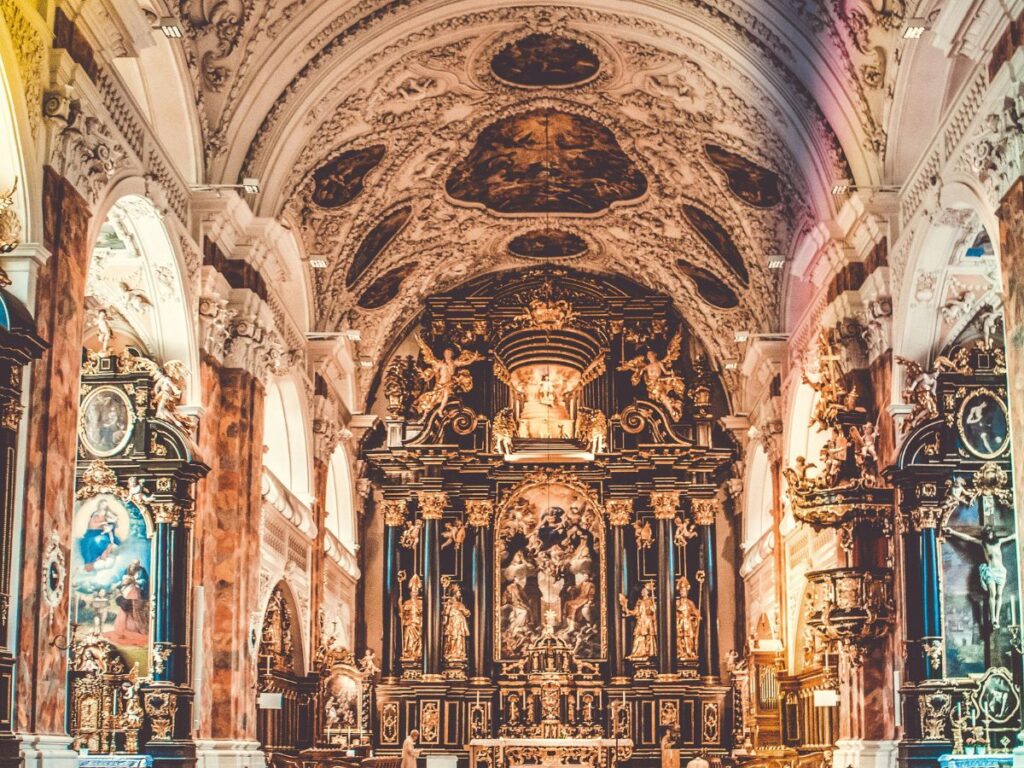
Casa Loma
Casa Loma, often referred to as Toronto’s fairy-tale castle, is a landmark embodying Gothic Revival architecture. Constructed from 1911 to 1914 for financier Sir Henry Pellatt, it stands as a testament to early 20th-century opulence. Known for its towering turrets, secret passageways, and sprawling gardens, Casa Loma offers a glimpse into a bygone era of Canadian aristocracy. This historic building in Toronto is not only a museum but also hosts seasonal events, making it a dynamic part of Toronto’s cultural landscape. Its unique features include decorated suites, an antique car collection, and a stunning view of Toronto from the Queen’s Own Rifles of Canada Regimental Museum on the third floor. If you’re interested in exploring more cultural sites after visiting these historic landmarks, be sure to check out the best museums in Toronto, where you can immerse yourself in the city’s rich art and history.
Old City Hall
Old City Hall, an iconic Romanesque Revival structure, served as Toronto’s city hall from 1899 to 1966. Designed by architect E.J. Lennox, its distinctive features include a 104-meter clock tower and intricate sandstone carvings. Beyond its architectural beauty, it has a rich history, having housed the city’s council chambers and offices. Today, it functions as a court building and remains a top historic building in Toronto, drawing visitors with its grandeur and historical significance. The building’s design, complete with gargoyles and arched windows, reflects the ambitions of a growing Toronto at the turn of the century.
Address: 60 Queen St W, Toronto, ON M5H 2M3, Canada
Architectural style: Romanesque Revival architecture
Contact: +1 416-338-0338
St. Lawrence Hall
St. Lawrence Hall, built in 1850, stands as a symbol of Toronto’s mercantile past. Known for its Neoclassical architecture, this building was the city’s social and cultural center, hosting balls, concerts, and public meetings. Renovated in the 1960s to restore its Victorian elegance, St. Lawrence Hall now features a grand ballroom that continues to be a sought-after venue for events. Its architectural specialties include a domed roof and a striking façade, making it one of the best historic sites in Toronto for architectural enthusiasts and historians alike.
Address: 157 King St E, Toronto, ON M5C 1G9, Canada
Architectural style: Renaissance Revival architecture
Contact: +1 416-392-7809
Fort York
Fort York, Toronto’s 18th-century military fortification, is a crucial historic site representing Canada’s defense history. Established in 1793, it played a significant role during the War of 1812, surviving multiple attacks. Today, it stands as a National Historic Site, offering visitors a chance to explore original war-era buildings, cannons, and military artifacts. Its architecture, featuring earthwork walls and wooden barracks, transports visitors back to early Toronto, providing a tangible link to the city’s colonial past. Fort York is not just among the oldest buildings in Toronto but also a living museum, hosting reenactments and educational programs.
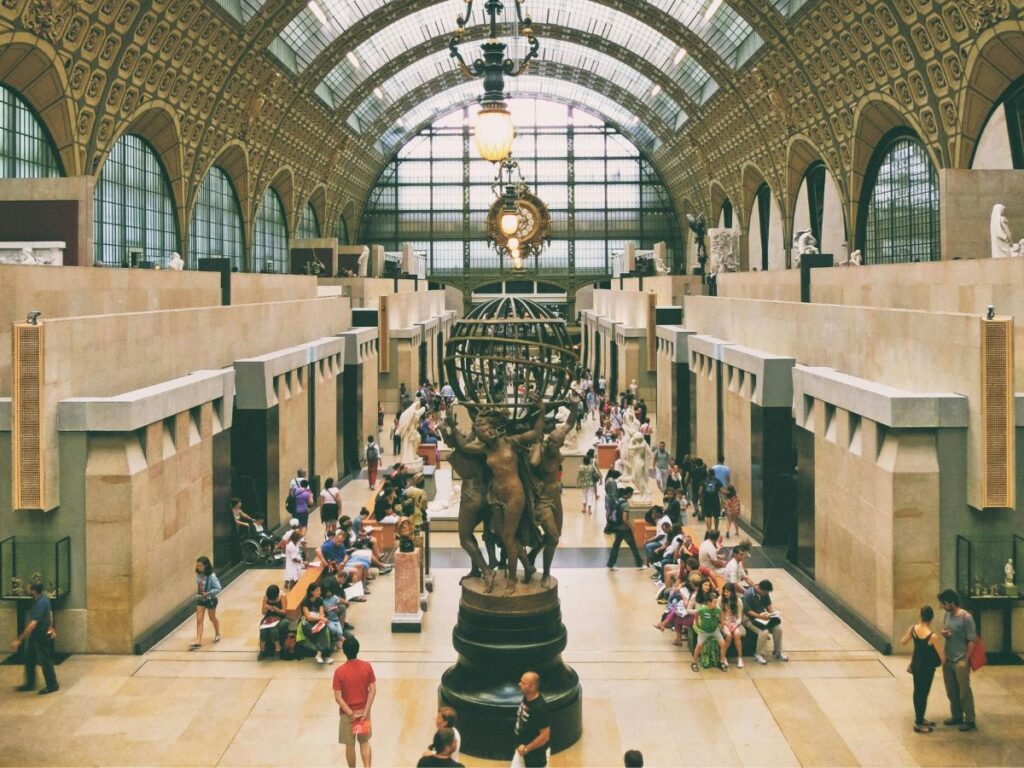
Osgoode Hall
Osgoode Hall, a landmark within Toronto’s legal landscape, houses the Ontario Court of Appeal, the Divisional Court of the Superior Court of Justice, and the Law Society of Ontario. Dating back to 1829, this historic building is famed for its neoclassical architecture, including ornate iron gates, a grandiose interior, and meticulously landscaped gardens. Osgoode Hall’s unique features, such as its stained glass and intricate woodwork, showcase the craftsmanship of its era. As one of Toronto’s best historic buildings, it remains a central figure in Ontario’s legal history and architectural heritage, providing insight into the judicial and societal norms of 19th-century Canada.
Address: 130 Queen St W, Toronto, ON M5H 2N5, Canada
Architectural styles: Neoclassical architecture, Georgian architecture, Palladian architecture
Contact: +1 416-947-3300
Spadina House
Spadina House, also known as Spadina Museum, offers a dive into Toronto’s Victorian period. This historic mansion, completed in 1866 and expanded over the years, was the residence of the Austin family until 1982 when it became a museum. Known for its beautifully preserved interiors that reflect the 1920s and 1930s, the house showcases the lifestyle of Toronto’s upper-class during that era. Architecturally, it blends Victorian and Edwardian styles, featuring ornate decorations, a grand staircase, and authentic furnishings. Spadina House stands out among historic buildings in Toronto for its lush gardens and as a testament to the city’s evolving history.
Address: 285 Spadina Rd, Toronto, ON M5R 2V5, Canada
Architectural style: Art Nouveau Architecture
Contact: +1 416-392-6910
Elgin and Winter Garden Theatre
The Elgin and Winter Garden Theatre Centre, the world’s last operating double-decker theatre, is a marvel of Edwardian construction. Opened in 1913, this venue consists of two separate theatres, the Elgin and the Winter Garden, stacked on top of each other. Known for its lavish design, including ornate plasterwork and a unique collection of vaudeville scenery, the theatre has been meticulously restored to its original grandeur. It hosts a variety of performances, making it a vibrant part of Toronto’s cultural scene. This historic site in Toronto is celebrated for its exceptional acoustics and the enchanting, leafy interior of the Winter Garden.
Address: 189 Yonge St, Toronto, ON M5B 1M4, Canada
Contact: +1 416-314-2901
Massey Hall
Massey Hall, established in 1894, is one of Toronto’s best-known cultural venues and has been a cornerstone of the city’s arts scene. Famous for its outstanding acoustics and distinctive Moorish Revival architecture, Massey Hall has hosted countless notable performances, from music concerts to public lectures. Its red-brick exterior and iconic tower make it a landmark in the city. Having undergone significant restorations, Massey Hall continues to be a premier destination for performances, embodying the historical and cultural fabric of Toronto.
Address: 178 Victoria St, Toronto, ON M5B 1T7, Canada
Architectural style: Neoclassical architecture
Contact: +1 416-872-4255
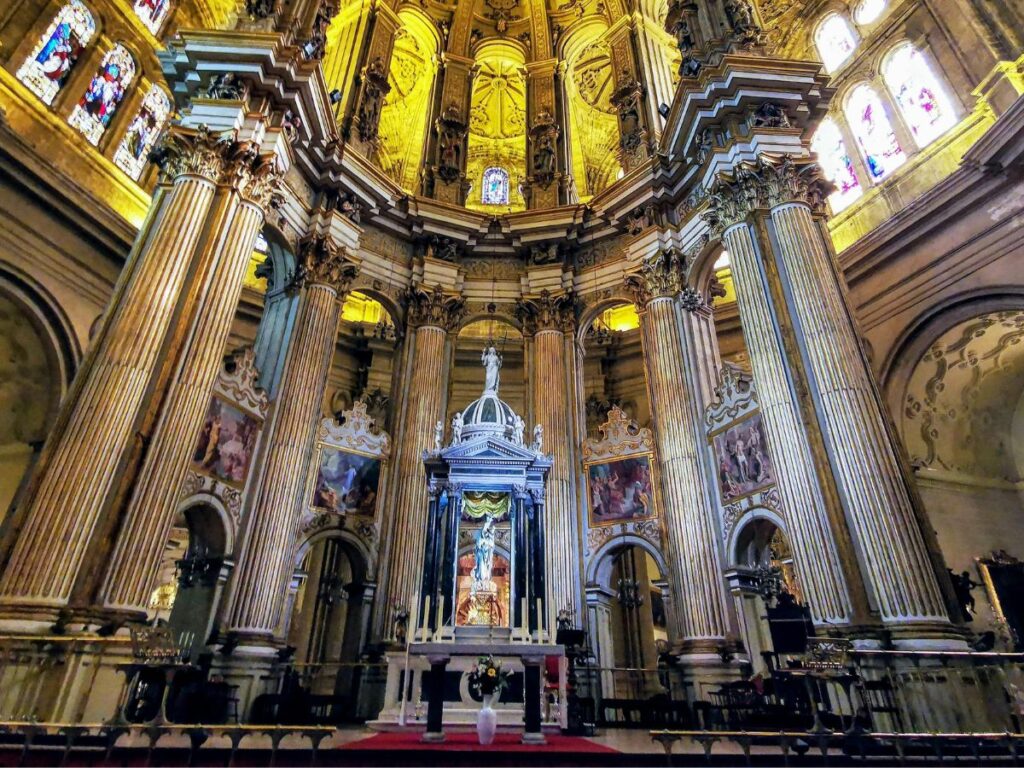
Gooderham Building
The Gooderham Building, also known as the Flatiron Building, predates its more famous New York namesake and is an iconic piece of Toronto’s architectural heritage. Completed in 1892, this wedge-shaped building is celebrated for its distinctive Romanesque and Gothic Revival styles. Its narrow front, broad rear, and red brick façade make it a photographic favorite. The building’s history is rooted in the city’s industrial past, originally serving as the office for the Gooderham & Worts Distillery. Today, it stands as a testament to Toronto’s dynamic urban transformation and is among the top historic buildings in Toronto.
Address: 49 Wellington St E, Toronto, ON M5E 1C9, Canada
Architectural styles: Romanesque Revival architecture, French Gothic architecture
Contact: +1 416-392-1975
Campbell House
Campbell House is the oldest remaining house from the original site of Toronto, built in 1822 for Judge William Campbell and his family. This Georgian-style mansion was moved to its current location in 1972 to save it from demolition. Known for its elegant architecture and as a rare example of Georgian style in Toronto, Campbell House provides insight into the city’s early judicial and social life. It now serves as a museum and heritage site, offering a glimpse into 19th-century Toronto and functioning as a public space for historical education and cultural activities.
Address: 160 Queen St W, Toronto, ON M5H 3H3, Canada
Architectural style: Georgian architecture
Contact: +1 416-597-0227
Gibson House
Gibson House, built in 1851, is a prime example of Georgian architecture in Toronto and serves as a museum depicting 19th-century rural life in Ontario. This historic building in Toronto was the home of David Gibson, a Scottish immigrant and prominent land surveyor. Known for its authentic period rooms and preserved artifacts, Gibson House offers a detailed look into the domestic and working life of its time. The museum conducts various historical and cultural programs, making it a dynamic educational site. Its distinctive features include the original farmhouse structure and a welcoming atmosphere that transports visitors back to the 19th century.
Address: 5172 Yonge St, Toronto, ON M2N 5P6, Canada
Contact: +1 416-395-7432
Colborne Lodge
Colborne Lodge, located at the south end of High Park, is a Regency-style cottage built in 1837 for John and Jemima Howard, the founders of High Park. This historic building in Toronto is known for its picturesque setting and architectural charm, featuring original furnishings and artifacts from the Howards’ life. The lodge provides insights into the early history of Toronto and the lifestyle of its upper class. Its specialities include the preserved art studio of John Howard, an avid painter, and the beautifully maintained gardens, offering a glimpse into the city’s past amidst natural beauty.
Address: 11 Colborne Lodge Dr, Toronto, ON, Canada
Contact: +1 416-392-6916
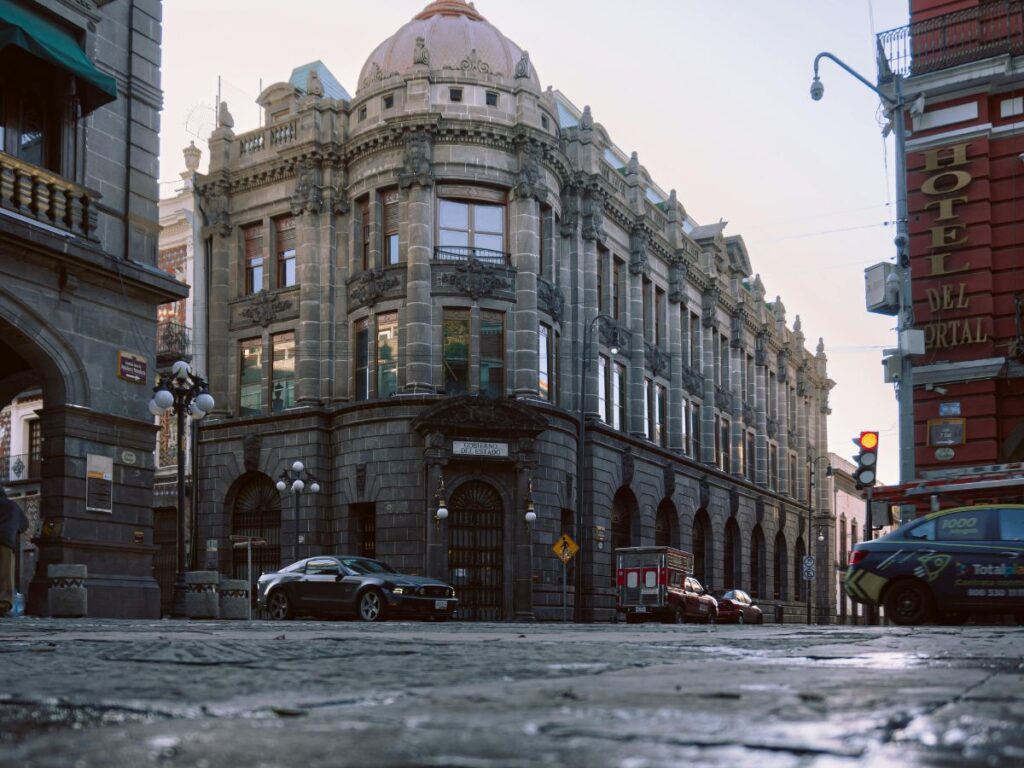
Mackenzie House
Mackenzie House, a 19th-century row house, was the last home of William Lyon Mackenzie, Toronto’s first mayor and leader of the Upper Canada Rebellion in 1837. Known for its Greek Revival architecture, the house is now a museum that showcases the city’s reformist history and Mackenzie’s life and legacy. This historic site in Toronto is unique for its interactive exhibits, including a working 19th-century printing press, and offers educational programs that highlight Toronto’s political history and the evolution of its civic life.
Address: 82 Bond St, Toronto, ON M5B 1X2, Canada
Architectural style: Georgian architecture
Contact: +1 416-392-6915
Union Station
Union Station, Toronto’s grand railway station, was opened in 1927 and is an excellent example of Beaux-Arts architecture. Known as the busiest transportation hub in Canada, this historic building in Toronto has a massive great hall with towering ceilings and opulent details. Union Station is not only a key part of the city’s infrastructure but also a landmark of its architectural and historical significance, having undergone extensive restoration to preserve its heritage while serving modern needs.
Address: 55 Front St W, Toronto, ON M5J 1E6, Canada
Royal Ontario Museum
The Royal Ontario Museum (ROM), known for its diverse and extensive collections, stands out as one of Toronto’s most prominent cultural institutions. The ROM blends historic architecture with modern design, notably in the Michael Lee-Chin Crystal addition, a striking example of Deconstructivist architecture. Established in 1914, it has grown to house over six million items spanning natural history, art, and culture from around the world. This museum is not only a top historic building in Toronto but also a dynamic space for learning and exploration, reflecting the city’s global connections and cultural diversity.
Address: 100 Queens Park, Toronto, ON M5S 2C6, Canada
Architectural styles: Romanesque Revival architecture, Neo-Byzantine architecture
Contact: +1 416-586-8000
Art Gallery of Ontario (AGO)
The Art Gallery of Ontario, one of the largest art museums in North America, is renowned for its expansive collection of more than 90,000 works, including Canadian, European, African, and contemporary art. The AGO’s history dates back to 1900, and its architectural evolution culminated in a transformative expansion by architect Frank Gehry in 2008. Known for its flowing glass façade and wooden interior, the gallery creates a welcoming and illuminating environment for art. The AGO is not just one of the top historic buildings in Toronto but also a center for artistic innovation and education, reflecting the city’s diverse cultural fabric. To fully appreciate the cultural richness of Toronto, complement your visit to its historic buildings with a tour of the finest art galleries in Bloor-Yorkville.
Address: 317 Dundas St W, Toronto, ON M5T 1G4, Canada
Contact: +1 416-979-6648

Toronto Dominion Centre
The Toronto Dominion Centre, a landmark of modernist architecture, is a complex of six skyscrapers in the heart of Toronto’s financial district. Designed by Mies van der Rohe and completed in the 1960s, it represents the International style with its minimalist form and use of black steel and glass. The centre is known for its uniform design and as a symbol of Canada’s economic strength. It houses major financial institutions and offers a public plaza that contributes to the city’s urban landscape, making it a pivotal historic site in Toronto’s architectural and commercial history.
Address: 66 Wellington St W, Toronto, ON M5K 1A1, Canada
Contact: +1 416-869-1144
Commerce Court North
Commerce Court North, part of the larger Commerce Court complex, is an iconic building in Toronto’s financial district. Completed in 1931 and designed in the Beaux-Arts style, it was once the tallest building in the British Empire. Its striking features include a grand banking hall with ornate detailing and a towering, cathedral-like ceiling. Known for its architectural beauty and historical significance, Commerce Court North reflects the prosperity and ambition of early 20th-century Toronto, embodying the city’s commercial heritage.
Address: 25 King St W, Toronto, ON M5L 2A1, Canada
Contact: +1 416-364-2281
Hart House
Hart House, located on the University of Toronto campus, is a student activity center known for its collegiate Gothic architecture and cultural impact. Built in the 1910s, it has been a hub for artistic, cultural, and recreational activities, including theatre, music, and debates. Hart House’s unique features include a stunning Great Hall, an art gallery, and various recreational facilities. It serves as a vibrant community space where students and the public engage in intellectual and cultural pursuits, making it one of Toronto’s best historic buildings for cultural enrichment.
Architectural style: Gothic Revival architecture
E.J. Lennox House
The E.J. Lennox House, designed by and built for the prominent architect E.J. Lennox himself, is a testament to his architectural legacy in Toronto. Known for designing Old City Hall and Casa Loma, Lennox’s personal residence reflects the Richardsonian Romanesque style, characterized by robust masonry and intricate details. This historic building in Toronto, located in the Annex neighborhood, showcases Lennox’s design prowess and personal taste. While not as publicized as his more grandiose projects, the E.J. Lennox House remains an important part of Toronto’s architectural heritage, offering insight into the life and style of one of its most influential architects.
Address: Toronto, ON M5H 4A6, Canada
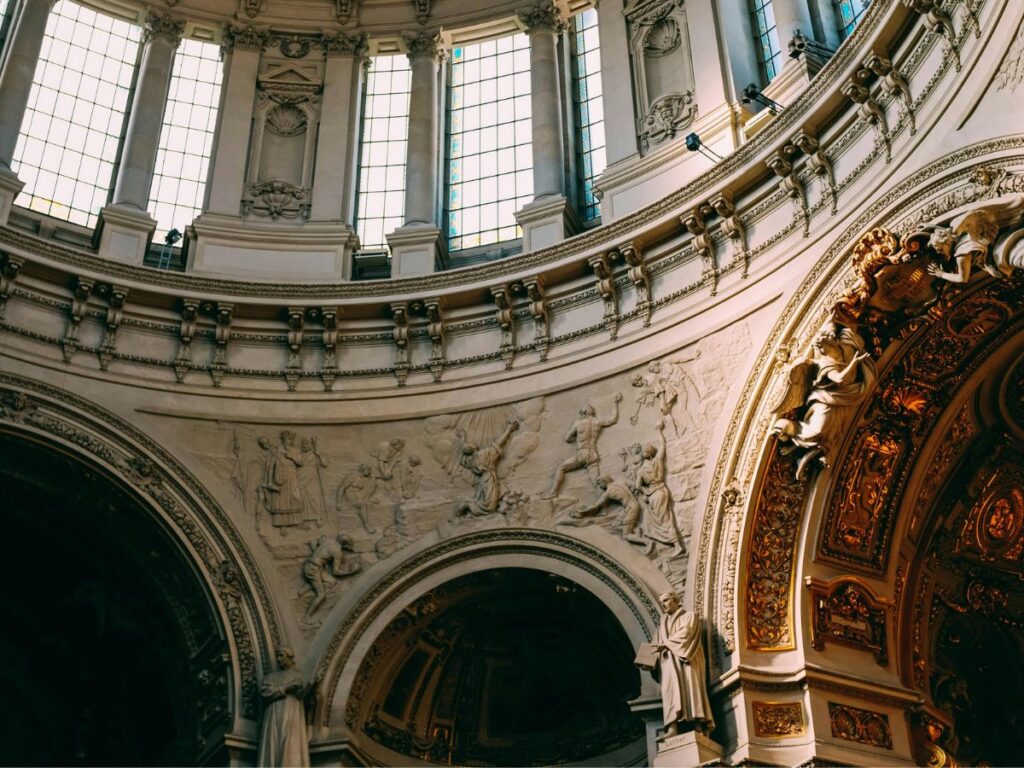
Distillery Historic District
The Distillery Historic District, located in Toronto, is a national historic site and one of the city’s most picturesque locations, known for its well-preserved Victorian industrial architecture. This area was once home to the largest distillery in the British Empire, Gooderham & Worts. Today, it’s a vibrant neighborhood featuring cobblestone streets, unique shops, art galleries, and restaurants. The district’s blend of historic buildings and contemporary culture makes it a must-visit destination in Toronto, showcasing a successful preservation and repurposing of industrial heritage into a thriving arts and entertainment hub. To complete your historical tour of Toronto, don’t forget to check out the best restaurants in the Distillery District, where you can enjoy exquisite cuisine in a beautifully preserved heritage setting.
Black Creek Pioneer Village
Black Creek Pioneer Village offers a journey back to 19th-century Ontario, featuring over 40 historic buildings in Toronto, including homes, shops, and public buildings. Known for its immersive experience, the village allows visitors to explore the daily life of early settlers through interactive exhibits, demonstrations, and costumed interpreters. Architecturally, the village encompasses a range of styles from simple log cabins to the more elaborate Victorian farmhouse, providing a comprehensive view of the period’s building techniques and community structure, making it a living history museum of great educational value.
Address: 1000 Murray Ross Pkwy, Toronto, ON M3J 2P3, Canada
Contact: +1 416-736-1733
High Park’s Jamie Bell Adventure Playground
High Park’s Jamie Bell Adventure Playground is notable not just for its recreational value but also for its unique design elements inspired by historic castles and fairy-tale aesthetics. While not a historic building in the traditional sense, the playground incorporates elements like turrets, wooden ramparts, and thematic sculptures that reflect a playful nod to architectural history. The playground, rebuilt with community involvement after a fire in 2012, represents a modern interpretation of historical design, fostering imagination and adventure in one of Toronto’s most beloved public parks.
Address: 185 Spring Rd, Toronto, ON M6R 2Y8, Canada
Contact: +1 647-707-6241
The Grange
The Grange, built in 1817 and now part of the Art Gallery of Ontario, is one of the oldest buildings in Toronto. Originally the home of the Boulton family, The Grange is a fine example of Georgian architecture. Its significance lies in its connection to the city’s social history and its evolution from a family residence to a public art institution. This building provides insight into the early 19th-century life in Toronto and serves as a historical backdrop to the modern extensions of the AGO, blending the city’s art and history seamlessly.
Address: 317 Dundas St W, Toronto, ON M5T 1G4, Canada
Contact: +1 416-979-6660
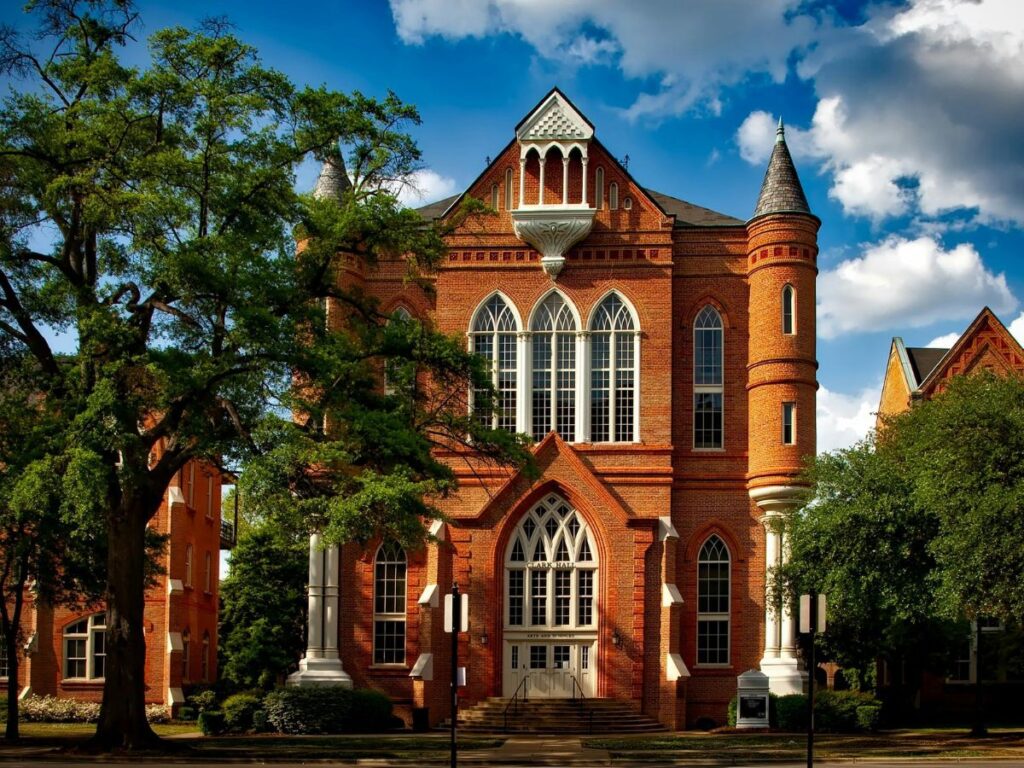
Queen’s Park Legislative Building
The Queen’s Park Legislative Building, home to the Ontario provincial government, is an iconic structure in Toronto, completed in 1893. Known for its impressive Richardsonian Romanesque architecture, the building features a prominent tower, intricate stone carvings, and a grand legislative chamber. It plays a key role in the province’s political life and is open to the public for tours, offering a glimpse into Ontario’s legislative process and history. The building’s architecture and function make it a central piece of Toronto’s governmental and historical landscape, symbolizing the city’s civic pride and heritage.
Address: 1 Queens Park, Toronto, ON M7A 1A8, Canada
First Post Office
The First Post Office in Toronto, officially known as Toronto’s First Post Office (built in 1833), is a working post office as well as a museum. It’s one of the oldest buildings in Toronto, known for its Georgian architecture. This historic site offers a glimpse into the city’s early communication systems, featuring a restored 19th-century post office where visitors can send mail with period-correct postage and handwriting tools. The First Post Office stands out for its educational programs and its preservation of postal history, serving as a unique window into Toronto’s past and continuing its legacy as a functional post office.
Address: 260 Adelaide St E, Toronto, ON M5A 1N1, Canada
Contact: +1 416-865-1833
John Cox Cottage
John Cox Cottage, one of the oldest known houses in Toronto, built around 1807, is significant for its age and architectural style. This historic building is a rare example of early Canadian settler architecture, made primarily of log construction. While it has been updated over the years, John Cox Cottage retains much of its original character, offering insights into the living conditions and lifestyles of early Toronto settlers. The cottage, situated in the modern urban environment, serves as a poignant reminder of the city’s humble beginnings and its development over centuries.
Address: 469 Broadview Avenue, Toronto, Ontario, Canada
Montgomery’s Inn
Montgomery’s Inn, an early 19th-century inn located in the Etobicoke area of Toronto, has been transformed into a museum that showcases the life and times of early settlers and travelers. Built in 1830, this historic building is known for its Georgian architecture and has been restored to reflect its operation as an inn. Montgomery’s Inn features period-appropriate furnishings, artifacts, and exhibits, offering a comprehensive look at the social and economic aspects of life in 19th-century Ontario, including its role as a community hub and a stopover for travelers.
Address: 4709 Dundas St W, Toronto, ON M9A 1A8, Canada
Architectural style: Georgian architecture
Contact: +1 416-394-8113
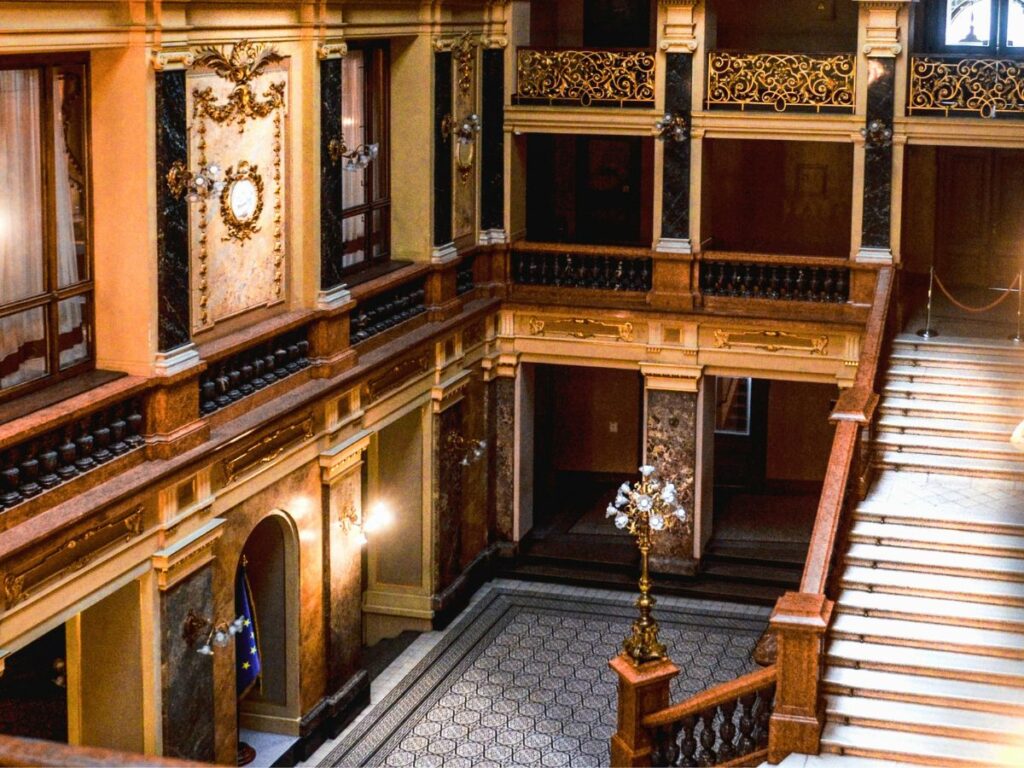
Scarborough Historical Museum
The Scarborough Historical Museum, set within Thomson Memorial Park, is dedicated to preserving the history of the Scarborough community. The museum consists of several historic buildings, including the Cornell House, the McCowan Log House, and the Kennedy Gallery. These structures, dating back to the 19th century, reflect the architectural and historical diversity of the area, from rural farmhouse styles to more urbanized developments. The museum provides a valuable educational resource, showcasing the agricultural history, domestic life, and community development of Scarborough.
Address: 1007 Brimley Rd, Toronto, ON M1P 3E8, Canada
Contact: +1 416-338-8807
Todmorden Mills Heritage Site
Todmorden Mills Heritage Site, nestled in the Don Valley, is a small industrial settlement dating back to the 1790s. This historic site in Toronto includes a collection of historic buildings and a museum that tells the story of the area’s industrial and ecological history. The site comprises the Papermill Theatre and Gallery, the Brewery Gallery, and restored historic homes that demonstrate the evolution of the area from an industrial mill to a cultural heritage site. Todmorden Mills is unique for its focus on both the natural and industrial history of Toronto, offering visitors a comprehensive view of the city’s development over time.
Address: 67 Pottery Rd, Toronto, ON M4K 2B9, Canada
Contact: +1 416-396-2819
Conservation Efforts
In Toronto, the conservation of historic buildings is a priority, reflecting the city’s commitment to preserving its rich architectural heritage. These efforts are supported by a combination of local government initiatives and heritage organizations, working together to maintain the structural integrity and historical significance of these landmarks. The City of Toronto’s Heritage Preservation Services plays a pivotal role, designating properties under the Ontario Heritage Act, ensuring they are protected for future generations. Organizations like Heritage Toronto and the Architectural Conservancy of Ontario advocate for conservation, offer educational programs, and raise public awareness about the value of historic preservation. Funding and grants are available to assist property owners with restoration projects, maintaining the character of Toronto’s historic sites. These concerted efforts ensure that historic buildings in Toronto continue to tell the city’s story, contributing to its cultural and historical landscape.
Visiting Historic Buildings in Toronto
Tourists interested in exploring the historic buildings in Toronto will find a wealth of options, from guided tours to self-guided walks. Many of these sites offer regular tours, with hours and ticket information available on their respective websites. For example, Casa Loma and Fort York provide immersive experiences, often with guides dressed in period attire, adding to the historical ambiance. Planning is essential, especially during peak tourist seasons or when special events or festivals take place, which can highlight the city’s heritage, such as Doors Open Toronto, when buildings usually closed to the public open their doors for a weekend. Cultural events and historical reenactments can also offer a unique way to experience these sites. Visitors are encouraged to check the schedule of events, book tickets in advance where necessary, and consider the location and accessibility of each historic building in Toronto to maximize their journey through the city’s past.
Key Takeaways
- Toronto’s architectural heritage is rich and diverse, featuring historic buildings that span various styles and eras, each with its own unique story and significance.
- Key historic buildings like Casa Loma, Old City Hall, and the Distillery Historic District offer insights into Toronto’s cultural, social, and economic history.
- Conservation efforts in Toronto are robust, involving local government and heritage organizations working collaboratively to preserve the city’s historic architecture for future generations.
- Visiting these historic sites provides a tangible connection to the past, with many offering tours, exhibits, and events that enhance the experience and understanding of Toronto’s history.
- Toronto’s historic buildings are not only important for their architectural and historical value but also play a vital role in the city’s ongoing cultural narrative, serving as venues for cultural events and community engagement.
- Planning a visit to these sites can be enriched by checking for special events, tours, and availability, allowing for a deeper exploration of Toronto’s heritage.
- The preservation and appreciation of historic buildings in Toronto are crucial for maintaining the city’s identity, educating residents and visitors, and fostering a sense of pride in Toronto’s historical legacy.
FAQs
- Can you visit the interiors of Toronto’s historic buildings?
Yes, many of Toronto’s historic buildings, like Casa Loma and Old City Hall, are open to the public with tours available. - What architectural styles are common in Toronto’s historic buildings?
Toronto’s historic buildings feature a range of architectural styles, including Gothic Revival, Romanesque, and Georgian. - Are there any conservation efforts for historic buildings in Toronto?
Yes, there are significant conservation efforts led by the City of Toronto and heritage organizations to preserve historic buildings. - What is the oldest building in Toronto?
The John Cox Cottage, built around 1807, is one of the oldest buildings in Toronto. - Is there an admission fee for visiting these historic buildings?
Some historic buildings have an admission fee, while others are free to visit or ask for a donation. - Are there any historic districts in Toronto worth exploring?
The Distillery Historic District is a notable historic area in Toronto, known for its well-preserved Victorian industrial architecture. - Do these historic buildings host any special events or festivals?
Yes, many historic buildings and sites in Toronto host special events, festivals, and cultural programs throughout the year. - Can you take photographs inside Toronto’s historic buildings?
Photography policies vary, with some buildings allowing photography and others restricting it, especially for commercial purposes. - Are there guided tours available for these historic buildings?
Yes, guided tours are available for many historic buildings, providing in-depth information and access to restricted areas.